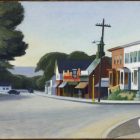The Best Short Story I Read in a Lit Mag This Week: “Shifts” by Dan Reiter
Aldous Huxley once wrote, “There are things known and there are things unknown, and in between are the doors of perception.” In Dan Reiter’s “Shifts” (WhiskeyPaper), we’re introduced to a character in conflict over how to accurately perceive a series of strange events, as shown through the narrator’s language and structure.
In the opening sentences, Reiter presents us with the inciting incident, a cup on the protagonist’s desk moving seemingly on its own. Notice the language.
“Hollow sound. Clat. Juke on the desk. Two-inch shimmy. Slip the pencils out, expecting a lizard. Empty, then. Indonesian piece. Carved, bas-relief delphinium. Smell of oil, deadwood. Wag the cup to your ear. Listen for termites.”
The barrage of sensory details, thoughts, and movements written in clipped phrases and short sentences gives immediacy to the paragraph. This is a stream of consciousness. We are deep in the character’s perspective, experiencing it as if moment by moment.
But then—as the title suggests—the narrative shifts.
“An old mentor once said the greatest weakness of the journalistic medium is its inability to explain the supernatural without doing some injury to the truth. A certain immobility of the mind is encouraged at the newspaper. Even the most fantastical occurrence––the hop of a mango-wood pencil cup on your desk, example––must present itself as a colony of insects, or the unwitting knock of your own knee on the underside of the desk.”
Reiter pulls us out of that initial stream of consciousness section into a much more elevated type of thought, as represented by the longer sentences, smoother syntax, and loftier language. Such stark contrast creates not just a distance between the experience and the interpretation, but an opposition. It’s as though we’re experiencing two distinct processes of the brain arguing over what occurred.
As more and more unexplainable events happen—drawers open, vases topple—Reiter develops a structural element to reinforce the conflict of perspectives. Each section of the piece begins with a numbered event, showing a need by the protagonist to enforce some sort of order onto the unexplainable. But then even that structure gets stretched as more and more events occur.
“Nine, ten, eleven, twelve, thirteen, fourteen: slap of plumbing pipe in the wall; guitar crashes off the peg, vrum; broom shushes concrete; coffee cup clinks; door slams; toilet flushes. No one home but you.”
Notice the rush of numbers; it’s as though the protagonist can’t keep up with all of the unexplainable events. Momentum builds, and we’re wondering how much longer the narrative structure can hold and how much longer the protagonist can keep trying to explain these occurrences. Will the analytical side win out, with the final section one long, numbered, sweeping sentence, dismissing every mysterious occurrence with lofty, impenetrable prose? Or will it devolve instead into an even more formless stream of experiential language?
Reiter lands the piece somewhere in between.
“Fifteen: concrete light pole bows low before the truck. Explosion of secret neural system. Vibration of poinciana. A peeling back.
You need to explain. Need to clarify. To quantify.
But here is the reflection of all visible rays of light: everything that is lives. See that. Shimmer.”
The need to make sense of these events won’t go away any more than the events themselves. Their existence isn’t dependent on definition or lack thereof. So the resolution must be a compromise. While the structure remains—Fifteen—we get a sense that perhaps the analytical mind might be tethered within, not at peace, but perhaps more compliant.
When definitions don’t work, sometimes its best to just stand back and enjoy the shimmer. That’s good advice for reviewers, and perhaps all of us.



